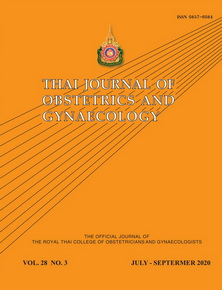Association between Anemia in Pregnancy and Preterm Birth at Sunpasitthiprasong Hospital
Main Article Content
Abstract
Objectives: To determine the association between anemia in pregnancy and preterm birth, maternal and neonatal complications.
Materials and Methods: A retrospective cohort study was conducted in pregnant women having a hemoglobin level at their first antenatal care and who delivered at Sunpasitthiprasong Hospital from January 2015 to December 2016. A total of 300 medical records of pregnant women were randomized from the database, of which 150 women were anemia (hemoglobin < 11 g/dL) and 150 women who were non-anemia (hemoglobin ≥ 11 g/dL). Maternal characteristics, gestation age of delivery, route of delivery, maternal and neonatal complications were recorded.
Results: Preterm birth in the anemic group (n = 11, 7.3%) was higher than those in non-anemic group (n = 7, 4.7%) but there were no significant differences (p = 0.332). Maternal complications showed no significant differences between the groups (postpartum hemorrhage p = 0.442 and pregnancy induce hypertension p = 0.759). With respect to neonatal complications, there were no significant differences between the groups (low birth weight p = 0.821, birth asphyxia at 1 minute p = 0.315, neonatal unit admission p = 0.143 and respiratory distress syndrome p = 0.570). There were no birth asphyxia at 5 minutes, necrotizing enterocolitis and intraventricular hemorrhage in the relevant groups.
Conclusion: There was no significant difference of preterm births between the anemic group and the non-anemic group. Regarding the maternal and neonatal complications, there were no significant differences between the groups.
Article Details
References
World Health Organization. The global prevalence of anemia in 2011. Geneva: World Health Organization 2015:1-36.
World Health Organization. Haemoglobin concentrations for the diagnosis of anaemia and assessment of severity. Vitamin and Mineral Nutrition Information System. Geneva: World Health Organization 2011:3.
Bureau of Policy and Strategy. Office of the Permanent Secretary. Ministry of Public Health. Thailand Health Profile 2011-2015. Bangkok: Ministry of Public Health 2015:184.
Cunningham FG, Leveno KG , Bloom SL, Spong CY, Dashe JS, Hoffman BL, et al. Williams Obstetrics. 24th ed. New York: McGraw-Hill 2014:653-59, 842,1102.
Okunade KS, Adegbesan-Omilabu MA, Oluwole AA. Perinatal outcome in anaemic pregnant women in South-Western Nigeria. Int J Res Med Sci 2014;2:607-11.
Bakhtiar UJ, Khan Y, Nasar R. Relationship between maternal hemoglobin and perinatal outcome. Rawal Med J 2007;32:102-4.
Lo NY, Lau BY, Leung KY, Wong WS. Perinatal outcomes among thalassaemia carriers in Hong Kong. Hong Kong J Gynaecol Obstet Midwifery 2014;14:75-81.
World Health Organization. Iron deficiency anaemia assessment, prevention and control: a guide for programme managers. Geneva: World Health Organization 2011:xii-9.
Arora CP, Kacerovsky M, Zinner B, Ertl T, Ceausu I, Rusnak I, et al. Disparities and relative risk ratio of preterm birth in six Central and Eastern European Centers. Croat Med J 2015;56:119-27.
Pitchaipraser S, Siwadune T. Correlation of maternal anemia during pregnancy and low birth weight infant at Chonburi Hospital. Thai J Obstet Gynaecol 2009;17: 17-22.
Zhang Q, Ananth CV, Li Z, Smulian JC. Maternal anaemia and preterm birth: a prospective cohort study. Int J Epidemiol 2009;38:1380-89.
Blencowe H, Cousens S, Oestergaard MZ, Chou D, Moller AB, Narwal R, et al. National, regional, and worldwide estimates of preterm birth rates in the year 2010 with time trends since 1990 for selected countries: a systematic analysis and implications. Lancet 2012; 379:2162-72.
American College of Obstetricians and Gynecologists. Committee on Practice Bulletin-Obstetrics. Practice Bulletin No. 130: Prediction and prevention of preterm Birth. Obstet Gynecol 2012;120: 964-73.
Smith GC, Pell JP, Dobbie R. Interpregnancy interval and risk of preterm birth and neonatal death retrospective cohort study. BMJ 2003;327:1-6.
Kidanto HL, Mogren I, Lindmark G, Massawe S, Nystrom L. Risks for preterm delivery and low birth weight are independently increased by severity of maternal anaemia. S Afr Med J 2009;99:98-102.
El-Sayed AM, Galea S. Temporal changes in socioeconomic influences on health: maternal education and preterm birth. Am J Public Health 2012;102:1715-21.
Butali A, Ezeaka C, Ekhaguere O, Weathers N, Ladd J, Fajolu I, et al. Characteristics and risk factors of preterm births in a tertiary center in Lagos, Nigeria. Pan Afr Med J 2016;24:1-8.
World Health Organization (WHO). Regional Office for the Western Pacific. The Asia-Pacific Perspective: Redefining obesity and its treatment. Sydney: Health Communications Australia 2000:18.
Yuan W, Duffner AM, Chen L, Hunt LP, Sellers SM, Bernal AL. Analysis of preterm deliveries below 35 weeks’ gestation in a tertiary referral hospital in the UK. A case-control survey. BMC Research Notes 2010;3: 119:1-10.
Rahman MM, Abe SK, Rahman MS, Kanda M, Narita S, Bilano V, et al. Maternal anemia and risk of adverse birth and health outcomes in low- and middle-income countries: systematic review and meta-analysis. Am J Clin Nutr 2016;103:495-504.
Di Renzo GC, Giardina I, Rosati A, Clerici G, Torricelli M, Petraglia F. Maternal risk factors for preterm birth: a country-based populati on analysis. Eur J Obstet Gynecol Reprod Biol 2011;159:342-6.
Rao CR, de Ruiter LE, Bhat P, Kamath V, Kamath A, Bhat V. A Case-control study on risk factors for preterm deliveries in a secondary care hospital, Southern India. ISRN Obstet Gynecol 2014;2014:935982:1-5.


